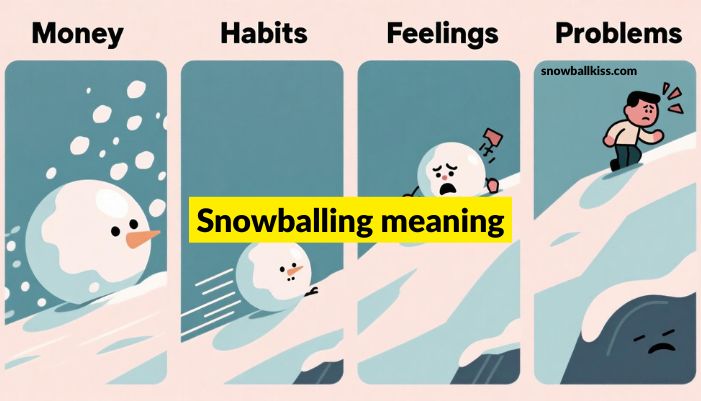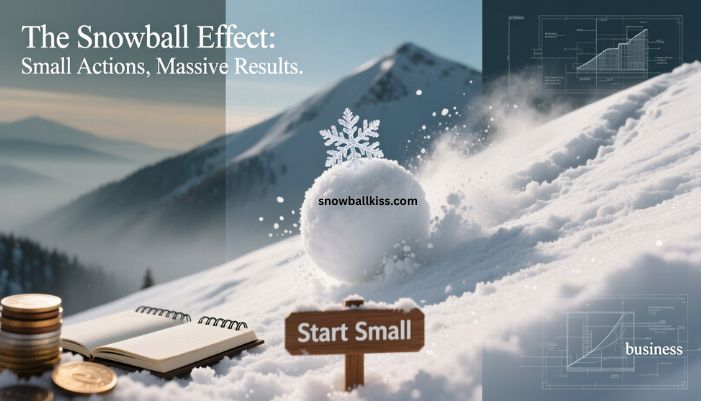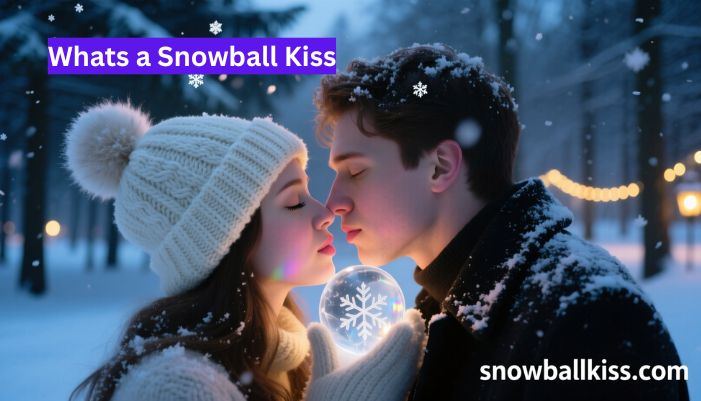Have you heard someone say, “It’s snowballing”? This word can sound strange. But it’s easy to understand once you see how it works.
This guide will explain what snowballing means. You’ll see how people use it when talking about money, habits, feelings, and problems. We’ll keep it simple.
What Does “Snowballing” Mean?
Think of a small snowball rolling down a hill. As it rolls, it picks up more snow. It gets bigger. It rolls faster.
That’s what snowballing means.
When something is snowballing, it starts small. But it keeps growing. It moves faster. Sometimes that’s good. Other times, it can be a problem.
Snowballing means:
- A small thing leads to more things.
- It keeps going without stopping.
- It gets bigger over time.
Now let’s look at how this shows up in real life.
How Snowballing Works in Money
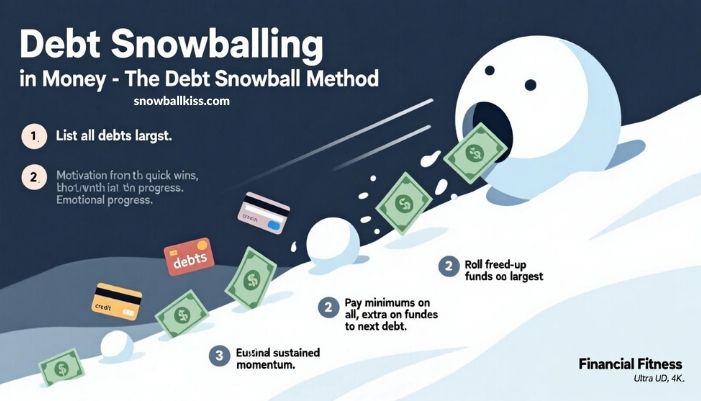
The Debt Snowball Method
You may have heard of the debt snowball method. It’s a way to pay off debt step by step.
Here’s how to do it:
- List all your debts. Put the smallest one first.
- Pay the minimum on all debts. But pay extra on the smallest one.
- When that one is gone, move to the next.
- Each time you pay off a debt, you have more money for the next one.
This works like a snowball. You build speed as you go. It helps you stay motivated. You see progress faster.
Why it helps:
- You feel good when you pay something off.
- You don’t feel stuck.
- You stay on track.
Even if it’s not the “best math,” it works for real people.
Snowballing in Habits and Behavior
Snowballing can happen with your choices too. One action leads to more actions. One small change becomes a big one over time.
Example: A Bad Habit
You skip the gym one day. You feel guilty. You eat junk food. You stay up late. Now you’re off track.
One small choice leads to more bad choices. That’s a negative snowball.
Example: A Good Habit
You go for a short walk. You feel better. You drink more water. You sleep early. The next day is easier.
That’s a good snowball.
Tip: Watch how one choice can lead to more. Keep the good ones going. Stop the bad ones early.
Snowballing in Emotions and Fights
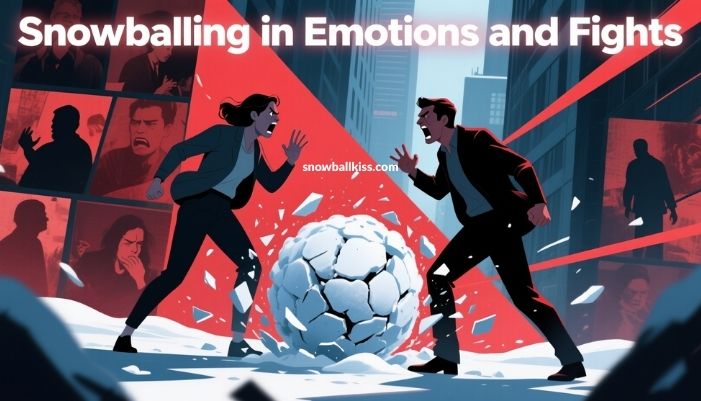
Have you had a small argument that turned into a big fight? That’s snowballing.
Here’s what can happen:
- Someone says something small.
- The other person gets upset.
- Old problems come up.
- Both people get angry.
- It turns into a big fight.
It can happen fast. You didn’t plan for it. But it keeps going.
How to stop it:
- Pause before reacting.
- Ask questions.
- Don’t bring up old stuff.
- Take a break if things get too heated.
Stopping the snowball early can save the relationship.
Snowballing at Work and in Projects
Snowballing can happen on the job too. A small delay can cause big problems.
Example:
- A file is late.
- A meeting gets canceled.
- A report doesn’t get finished.
- The client is unhappy.
That’s how small things grow fast at work.
How to stop it:
- Don’t wait to fix problems.
- Talk early and clearly.
- Ask for help if you’re stuck.
Fixing one thing early can stop the whole snowball.
Snowballing in Daily Life
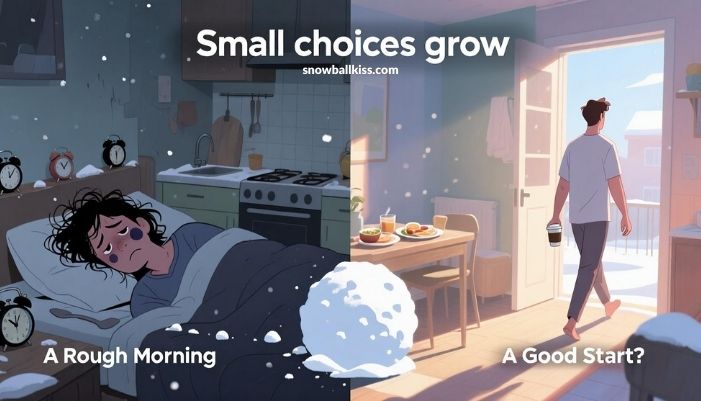
Snowballing shows up in small things you do every day.
Example 1: A Rough Morning
- You stay up late.
- You wake up tired.
- You skip breakfast.
- You feel grumpy all day.
One small thing starts the chain. Your whole day feels hard.
Example 2: A Good Start
- You sleep on time.
- You wake up early.
- You go for a short walk.
- You feel calm and focused.
Small wins lead to more wins. That’s the power of a good snowball.
Read: Snowball Effect: How Tiny Actions Lead to Massive Results
Snowballing on Social Media
Online, snowballing can make a small post go viral.
Here’s how:
- One person shares a video.
- Ten more people share it.
- It spreads fast.
- Everyone sees it.
This can be fun. But it can also spread lies.
Example:
- A false post is shared.
- People believe it.
- Others keep sharing.
- It becomes hard to stop.
Be careful. Always check before sharing. Don’t add to a bad snowball.
How to Use the Snowball Effect for Good
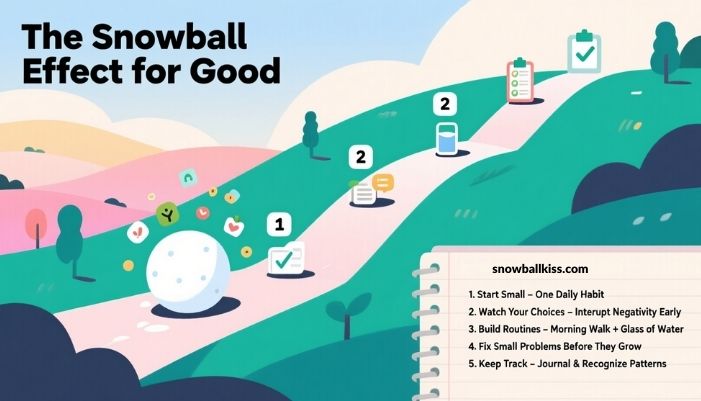
You can’t stop snowballing from happening. But you can use it the right way.
Here’s how:
1. Start Small
Pick one small habit. Do it every day. Let it grow.
2. Watch Your Choices
Notice when one bad choice leads to another. Step in early.
3. Build Routines
Make simple habits part of your day. Morning walk. Glass of water. Five-minute clean-up.
4. Don’t Let Things Slide
Fix small problems before they grow. Ask for help when needed.
5. Keep Track
Write things down. When you see patterns, you can change them.
Snowballing Isn’t Always Bad
Not all snowballs are scary. Some are great.
Here are good things that snowball:
- Kindness
- Healthy habits
- Learning
- Saving money
One kind word can brighten someone’s day. One dollar saved can become thousands. One book can change how you think.
Use snowballing to help yourself and others.
Final Thoughts
Snowballing means something small keeps growing. It can be good. It can be bad. It depends on how you use it.
Use snowballing to:
- Pay off debt
- Build good habits
- Stop fights from growing
- Fix small problems at work
- Make your life easier
One small step can lead to a big change. Start today.
FAQs About Snowballing
1. What is snowballing in simple words?
It means something small keeps growing bigger and faster over time.
2. Can snowballing be a good thing?
Yes. Good habits, savings, and learning can all snowball in a good way.
3. What is the debt snowball method?
You pay off your smallest debt first. Then you move to the next one. It builds momentum.
4. How can I stop a bad snowball?
Act fast. Fix problems early. Don’t wait for things to get worse.
5. Does snowballing only happen in money?
No. It can happen in habits, emotions, work, and daily life too.
